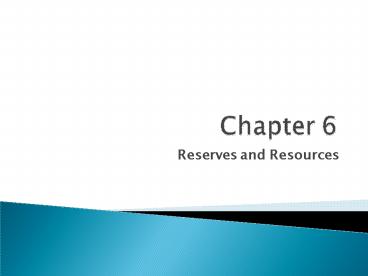Reserves and Resources PowerPoint PPT Presentation
1 / 22
Title: Reserves and Resources
1
Chapter 6
- Reserves and Resources
2
This chapter is a brief discussion the theory of
the mine.
- Though different sources of energy are good
substitutes, different energy industries may be
not. - It is necessary to consider specifically the
industries based on exhaustible minerals like
oil, those on renewable resources like sunlight,
and those converting energy from one form to
another like electricity.
3
Definitions
- Reserves, also called proved reserves, include
the minerals that can be extracted and sold at a
profit under current market conditions and that
have already been identified.
4
Definitions
- The reserves only include the top left corner.
5
Definitions
- The horizontal dimension is marked off according
to uncertainty. - The vertical axis is the market price where it is
just worth mining a particular deposit. - The vertical dimension can be also marked off
according to cost.
6
Definitions
- The cost dimension can be subdivided into
recoverable, paramarginal and submarginal cost. - The quality of a mineral can be summarized as
cost of extraction, transportation and use too.
7
Definitions
- The industry may be the best one to estimate the
cost of producing deposits. - Disadvantages of the data from the industry
- Negative bias because of taxation and price
regulation - Positive bias because of commercial purpose of
appearing strong and reliable
8
Definitions
- Reserves are expensive to buy, prove and hold,
but they permit firms to make long-range plans
for processing and marketing. - Reserves can be viewed as a kind of inventory.
Firms do not try to max or min it but to find the
appropriate amount of it to max profit (or other
goals).
9
Definitions
- Firms continue to add new reserves as them
exhaust the old. - The inherent assumption is reserves can always be
augmented if a firm is willing to pay the price.
10
How do we know what is there?
- A firm can increase reserves by buying them from
other firms but the economy cannot. - We are curious about the boundaries (total
availability) of the energy because of the fear
that economic calculations are too shortsighted.
11
How do we know what is there?
- It is not necessary to estimate the exact number.
- It is enough to know beyond the boundaries of
reserves there are deposits exploitable at higher
cost.
12
How do we know what is there?
- Three techniques of measurement
- 1. Volumetric (The simplest approach)
- 2. amount of mineral per unit of geological
structure amount of the structure. - It can be refined by adding the richness and
accessibility.
13
How do we know what is there?
- Crustal abundance (abundance in the earths
crust) not applicable to oil or coal
14
How do we know what is there?
- Behavioristic approach look at the history of
human exploitation rather than the geology. - Advantages forecast the decline in production
and make use of accurate available data.
15
How do we know what is there?
- Disadvantage the data used is irrelevant.
- Use the past data to forecast the future.
- Use the production data to estimate the
geological amount.
16
How do we know what is there?
- There are no real substitutes for detailed
geological exploration to estimate what is
underground. Therefore, the data on reserves is
the most meaningful for us.
17
Reserves and Resources of Major Fuels
- Reserves grew steadily with production until
1967. - After the discovery of Middle Eastern reserves,
the reserves in US tended to decline. The
decrease continued to the 1990s. It is partly
because the relative cheap reserve aboard induce
companies to invest aboard rather than in the US.
18
Reserves and Resources of Major Fuels
19
Reserves and Resources of Major Fuels
- The reserves appear quite bleak
- Reserves are less than 4 years consumption.
- Importing accounts for a half of consumption.
- The resources are identified more recisely.
20
(No Transcript)
21
(No Transcript)
22
(No Transcript)

